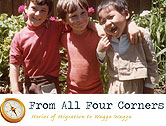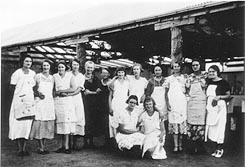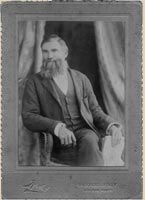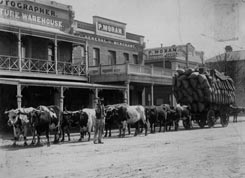 » View online exhibitio |
Many German migrants living in South Australia and Victoria moved to the Riverina after the 1861 Robertson Land Act provided for the selection of land for £1 per acre. In 1858, the town of Holbrook was locally known as ‘the Germans’ and it was officially changed to ‘Germantown’ in 1876. Communities in the Riverina grew and prospered in the late 19th and early 20th centuries with the success of the wool and agricultural industries. A number of townships in this area have maintained their Germanic populations.
Germantowns, Germanstories is a regional heritage study of places and collections associated with the history of German migration and settlement in the Museum of the Riverina’s local areas of Holbrook, Jindera, Ganmain, Lockhart, Milbrulong, Temora, Trungley Hall, Tumbarumba, Wagga Wagga and Walla Walla. The study supports the Museum’s ongoing work in documenting regional heritage collections.
 Trungley Hall catering c1935 |
Stage One of the study included a short, illustrated history of German migration and settlement in the Riverina from the 1850s to the present. It included research into community life, the development of local commerce and the growth of agricultural and wool industries. Complementing the Centre’s research on experiences of wartime internment at Trial Bay Gaol, the history recorded experiences of racial persecution and internment of German communities during the First and Second World Wars. The study is also of interest for its research into surviving German domestic collections and community folklore because there are few surviving people who remember the German migrants from first-hand experience.
Stephen Thompson, the NSW Migration Heritage Centre’s Movable Heritage Officer, assisted the Museum of the Riverina in writing statements of cultural heritage significance for collections held in local museums and historical societies. The objects are featured in the Collections Australia Network and the Centre’s Objects Through Time online exhibition.
Germantowns, Germanstories is a NSW Migration Heritage Centre partnership project with the Museum of the Riverina. The regional heritage study was contracted to local historian Annette Brown.
The heritage study culminated in the Museum of the Riverina and NSW Migration Heritage Centre exhibition From All Four Corners: Stories Of Migration To Wagga Wagga and associated public programs at Wagga Wagga from 1 June – 26 August 2007. The exhibition celebrated, explored and captured the personal stories of migrants coming to Wagga Wagga through five themes – Footsteps, Settling In, Keeping The Faith, Making Their Mark and New Future, New City. The NSW Migration Heritage Centre is making an online version in partnership with the Museum of the Riverina in late 2010.
The NSW Migration Heritage Centre also supported the associated National Art Glass Museum, Wagga Wagga exhibition Here They Came: Post-War Migration Of Glass Professionals To Australia in partnership with Powerhouse Museum Regional Services.
PROJECT CONTACT:
Annette Brown, Researcher, Germantowns, Germanstories, Museum of the Riverina
Address:
PO Box 20, Wagga Wagga NSW 2650
Tel: 02 6925 2934
Email: brown.annette@wagga.nsw.gov.au
THE MENNEKE BELL
Made by a German migrant blacksmith, the story of the Menneke bell and its place in Australian bush folklore suggests the success of migrants in establishing businesses and becoming part of rural community life.
 August Menneke (1838-1904) |
August Menneke was born in 1838 in Bakenem, Germany and arrived in New South Wales around 1858. Over one thousand German migrants made the Riverina home in the 19th century.
Menneke established his own blacksmith business in North Wagga Wagga immediately after his apprenticeship and by the 1870s had won fame, particularly for the goods he manufactured for bullock drivers. He reputedly had a perfect ear for the sound of a bell. They were used on a leader in a bullock team or on other stock so they could be easily located.
 A bullock team on Fitzmaurice Street, Wagga Wagga |
According to legend, a test was carried out on top of Mount Kosciusko to find the best bell maker in Australia. Menneke won when his bell could be heard ten miles away.
Menneke Bell donated to the Wagga Wagga & District Historical Society in 1970 by Fred Menneke (son of August Menneke).
August Menneke died in Wagga in 1904 and is remembered as a legendary bell-maker and fine blacksmith.
In the 1940s, Dame Mary Gilmore immortalised Menneke in Australian folklore through her poem Bells and Bullocks:
Once in a while we ask if he hears
The sound of Mennicke’s (sic) bells
Deep in the pits of his ancient ears
Repeating their olden spells
‘Mennicke’s bells?’ … Then he’ll say
Never heard none like ‘em
Mennicke, he had the way
No one else could strike ‘em
Photographs courtesy of the Museum of the Riverina

